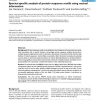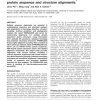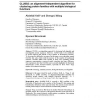148
click to vote
BMCBI
2005
15 years 29 days ago
2005
Background: The sequencing of the human genome has enabled us to access a comprehensive list of genes (both experimental and predicted) for further analysis. While a majority of t...
142
click to vote
BMCBI
2005
15 years 29 days ago
2005
Background: The alignment of multiple protein sequences is a fundamental step in the analysis of biological data. It has traditionally been applied to analyzing protein families f...
104
Voted
BMCBI
2005
15 years 29 days ago
2005
Background: Protein sequence motifs are by definition short fragments of conserved amino acids, often associated with a specific function. Accordingly protein sequence profiles de...
125
Voted
BIOINFORMATICS
2005
15 years 29 days ago
2005
Motivation: Remote homology detection between protein sequences is a central problem in computational biology. Supervised learning algorithms based on support vector machines are ...
98
Voted
NAR
2006
15 years 1 months ago
2006
MODBASE (http://salilab.org/modbase) is a relational database of annotated comparative protein structure models for all available protein sequences matched to at least one known p...
90
Voted
NAR
2006
15 years 1 months ago
2006
HHrep is a web server for the de novo identification of repeats in protein sequences, which is based on the pairwise comparison of profile hidden Markov models (HMMs). Its main st...
119
Voted
NAR
2008
15 years 1 months ago
2008
Multiple sequence alignments are essential in computational sequence and structural analysis, with applications in homology detection, structure modeling, function prediction and ...
IJCBDD
2008
15 years 1 months ago
2008
: CLUSS is an algorithm proposed for clustering both alignable and non-alignable protein sequences. However, CLUSS tends to be ineffective on protein datasets that include a large ...
133
Voted
BMCBI
2006
15 years 1 months ago
2006
Background: Comparison of large protein datasets has become a standard task in bioinformatics. Typically researchers wish to know whether one group of proteins is significantly en...
124
Voted
BMCBI
2006
15 years 1 months ago
2006
Background: Recent progress in cDNA and EST sequencing is yielding a deluge of sequence data. Like database search results and proteome databases, this data gives rise to inferred...







